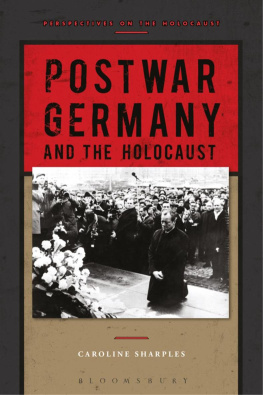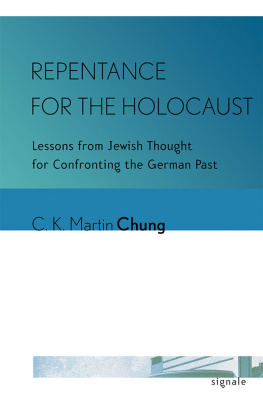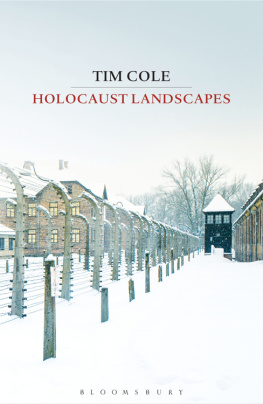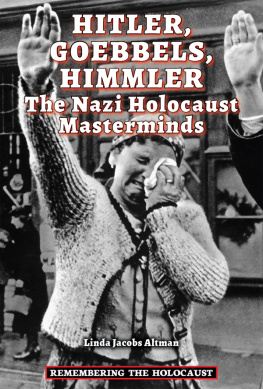Postwar Germany
and the HolocaustPERSPECTIVES ON THE HOLOCAUST
A series of books designed to help students further their understanding of key topics within the field of Holocaust studies.
PUBLISHED:
Holocaust Representations in History, Daniel H. Magilow and Lisa Silverman
Postwar Germany and the Holocaust, Caroline Sharples
FORTHCOMING:
Sites of Holocaust Memory, Janet Ward
Anti-Semitism and the Holocaust, Beth A. Griech-Polelle
The Holocaust in Eastern Europe, Waitman W. Beorn
Postwar Germany
and the Holocaust
Caroline Sharples
Bloomsbury Academic
An imprint of Bloomsbury Publishing Plc
Figure I. 1 Map showing the division of Germany and Berlin, 194990.
First and foremost, I wish to thank Rhodri Mogford for the original invitation to contribute to this book series, and for all his amazing support and patience during the production of this volume. Likewise, I would like to thank Emma Goode and everyone else at Bloomsbury for helping turn this project into a reality. Special mention must be made of Paul Moore for kindly taking on the task of reading and commenting upon drafts of some of this work. Similarly, I would also like to thank the anonymous reviewers for their constructive feedback along the way. Finally, I am most grateful to the Bildagentur fr Kunst, Kultur und Geschichte, Berlin, for granting the license to reproduce the Simplissimus cartoon in this volume.
CDU | Christian Democratic Union (German Film Corporation) |
DEFA | Deutsche Film-Aktiengesellschaft |
DPs | Displaced Persons |
EKD | German Evangelical Church |
FRG | Federal Republic of Germany (West Germany) |
GDR | German Democratic Republic (East Germany) |
HIAG | Mutual Help Association of Former Waffen-SS Members (veterans organization). |
IfD | Institut fr Demoskopie (Institute for Public Opinion Research) |
IHRA | International Holocaust Remembrance Alliance |
IMT | International Military Tribunal |
KMK | Kultusministerkonferenz zu Toleranz und Solidaritt (Standing Conference of the Ministers of Education and Cultural Affairs of the Lnder) |
KPD | German Communist Party |
KZ | Konzentrationslager (Concentration Camp) |
NSDAP | National Socialist German Workers Party (Nazi Party) |
NWRV | Nord- und Westdeustche Rundfunk (North and West German Broadcasting) |
OMGUS | Office of the Military Government United States |
POWs | Prisoners of War |
RSHA | Reichssicherheitshauptamt (Reich Security Main Office) |
SA | Sturmabteilung (Storm Detachment) |
SD | Sicherheitsdienst (Security Service) |
SED | Socialist Unity Party |
SPD | Social Democratic Party |
SS | Schutzstaffel (Protection Squad, an elite Nazi paramilitary organization) |
TNA | The National Archives, London |
USHMM | United States Memorial Museum |
VVN | Vereinigung der Verfolgten des Naziregimes (Association of Persecutees of the Nazi Regime) |
WDR | Westdeutsche Rundfunk (West German Broadcasting) |
ZDF | Zweites Deutsches Fernsehen (Second German Television) |

FIGURE I.1Map showing the division of Germany and Berlin, 194990.
The beginning of the twenty-first century has witnessed a rapid growth in Holocaust consciousness. In 2000, forty-six countries from around the globe signed the Stockholm Declaration, pledging their commitment to promoting Holocaust education, remembrance and research, and emphasizing the continued, universal relevance of the Nazi genocide. There are now numerous museum exhibits, memorials, films and educational initiatives, all exploring the legacy of the Third Reich.
Germany has played a leading role in this process, being specifically invited, along with Israel, to form part of the International Holocaust Remembrance Alliance in 1998 as a result of its existing educational programmes in this area. Its own annual memorial day for the victims of National Socialism (Tag des Gedenkens an die Opfer des Nationalsozialismus) has been observed since 1996 with a special remembrance ceremony in the Bundestag and various lectures, film screenings, theatre productions and concerts taking place throughout the country. The nations landscape contains some 2,000 memorial sites to the Holocaust, ranging from the conservation of former concentration camps and Jewish cemeteries, to acts of memorialization at the points of deportation. An average of 450,000 people have visited the Information Centre for Berlins imposing, nineteen square metre Memorial to the Murdered Jews of Europe each year since its inauguration in May 2005.
All of this points to the Holocaust occupying a prominent place within German memorial culture and a nation that has successfully confronted However, the process of Germanys Vergangenheitsbewltigung (coming to terms with the past) has been protracted, painful and highly politicized. It did not happen overnight, nor is it a linear narrative of ever-greater engagement with the crimes of the Third Reich. Instead, it is a fascinating story of silences, mythologies, generational conflict and competing memories exacerbated by forty years of division and the subsequent challenges of reunification. Focusing on this complex process, this volume explores East, West and reunified German representations of Nazism and the various ways in which the Holocaust has found political, cultural and social expression since 1945.
Divided memories
The postwar division of Germany and Berlin into four occupation zones had been agreed in principle between the Allies at the Yalta Conference of February 1945, and confirmed in the Potsdam Agreement in August that same year. Four further Ds demilitarization, decartelization, denazification and democratization characterized Allied policy at this time and reflected their belief that Germany, now responsible for two devastating global conflicts, needed to be contained and re-educated so that it would never again threaten world peace. The division of Germany quickly came to symbolize the emerging Cold War tensions. In 1947, the British and American zones merged to form Bizonia (France would later follow suit to form Trizonia), and in 1948 a currency reform was announced for the western sectors, linked to the United States Marshall Aid programme. In response, the Soviets instigated an eleven-month blockade of Berlin from June 1948, compelling the British and Americans to organize the Berlin air lift to keep the city in supplies. Division was formalized in 1949 with the promulgation of the Federal Republic of Germany (FRG) from the western occupation zones on 23 May and the establishment of the German Democratic Republic (GDR) from the Soviet zone of occupation on 7 October. Despite its name, the latter was governed by the Socialist Unity Party (SED) and tied to the USSR. Both fledgling German states were quickly subsumed into their respective sphere of the Cold War alliances so that by 1955, the FRG had joined NATO and the GDR had become part of the Warsaw Pact between the USSR and its satellite states. The construction of the Berlin Wall in August 1961 an attempt to stop the brain drain of East German professionals fleeing into the western sector of the city literally cemented the division between the two states and became an iconic image of the Cold War until its fall on 9 November 1989.








